Bell Shaped Flowers (White, Purple, Red) – Pictures and Identification Guide
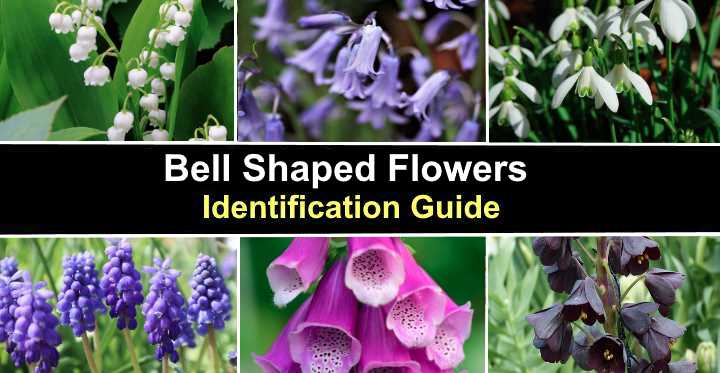
Plants with bell-shaped flowers are colorful, showy, sun or shade-loving garden varieties that give off beautiful fragrances. Usually, the bell-shaped flowers grow in dangling conical clusters and can be white, purple, pink or red. Some examples of these flower clusters are doghobble and Japanese Pieris. However, other bell-shaped flowers like snowdrops, bluebells, and lily of the valley grow on upright or arching stems on low-growing plants.
Bell-shaped flowers can look like tiny urns or small overturned cups. Some flowers that look like bells have an open shape with pointed petals. But there are also showy flowers in the form of bells that are elongated and look more like a champagne flute or funnel.
This article is a guide to identifying eye-catching varieties of plants with bell-shaped flowers. Some plants with flowers resembling bells, such as snowdrops or bluebells, are easy to identify. However, clusters of white bell-shaped flowers could belong to several species of plants.
The Best Plants with Flowers That Look Like Bells
The most easily recognizable bell-shaped flowers are white blooms like lily of the valley, snowdrops, and Japanese Pieris. The tallest plants with bell-like flowers are foxglove, with large thimble-shaped colorful blossoms growing on erect flowering spikes. Other showy bell-like flowers are Canterbury bells, doghobble, coral bells, and fuchsia.
Plants With White Bell-Shaped Flowers
Plants with white bell-shaped flowers are very common. These cup-like flowers are found on snowdrops, mountain heather, lily of the valley, doghobble, and Japanese Pieris. Let’s take a closer look at some of the most common plants with white bell-shaped flowers.
Lily of the Valley (Convallaria majalis)
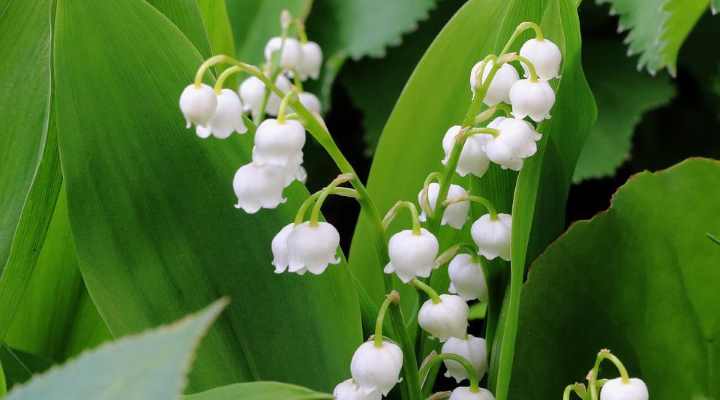
The delicate little white flowers of lily of the valley plant are bell shaped and grow in full or part shade
Lily of the valley has dainty white bell flowers growing singularly or in pairs on small green stems. The sweetly-scented nodding cup-like white flowers bloom in mid to late spring. The brilliant white bell flowers contrast with the low-growing plant’s glossy foliage. Lily of the valley grows 6” to 12” (15 – 30 cm) tall.
Lily of the valley has white bell-shaped flowers that consist of six fused tepals that form the shape of a rounded cup. These delicate flowers are best known for their aromatic scents when they bloom. As a spreading, low-growing plant, the lily of the valley is ideal for using as ground cover with white flowers.
Lily of the valley is a perennial plant that thrives in USDA zones 2 through 7 and performs best in shade or dappled sunlight.
Snowdrops (Galanthus nivalis)
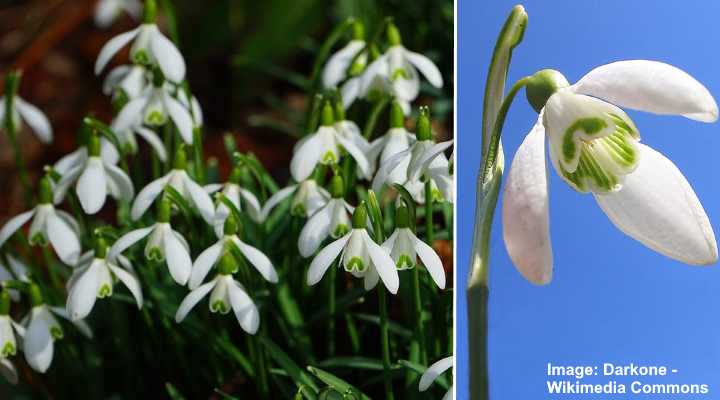
Snowdrops are cold hardy bulbous perennial plants with bell-like drooping dainty white blooms
Snowdrops are early blooming plants that produce drooping white bell-shaped flowers in late winter or early spring. The ground-spreading flowering plants produce a carpet of white blooms. The cold-hardy plants can also blossom under a blanket of snow. The dangling white flowers typically grow singularly on the end of short arching stems.
Bell-shaped snowdrops are usually tiny, nodding white flowers. Some snowdrop hybrids have white flowers that are double blossoms with several inner petals. Others are simple flowers in the shape of a bell formed by several fused petals.
Snowdrops perform well in USDA zones 3 through 8 and require shade or partial sunlight. The small plants only grow around 10” (25 cm) tall, making them excellent understory ground cover plants for full shade.
White Mountain Heather (Cassiope mertensiana)
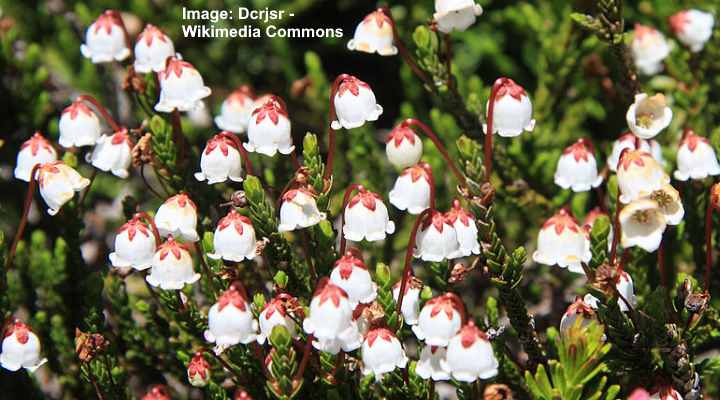
The white mountain heather is a cold hardy low growing evergreen shrub with white and red bell shaped flowers
White mountain heather has tiny white flowers in the shape of a bell growing on leathery leaves. The petite white flowers are characterized by reddish marks where they attach to the plant. This contrast of bright red with pure white colors against dark green foliage gives the low-growing bushy plant visual appeal.
Also called western moss heather and Arctic white heather, the plant is exceedingly cold-hardy. The subalpine plant thrives in full sun or complete shade. The short, snakelike glossy green stems blossom with bell-shaped flowers that dangle and face downward.
White mountain heather doesn’t grow taller than 12” (30 cm) high.
Japanese Pieris (Pieris japonica)
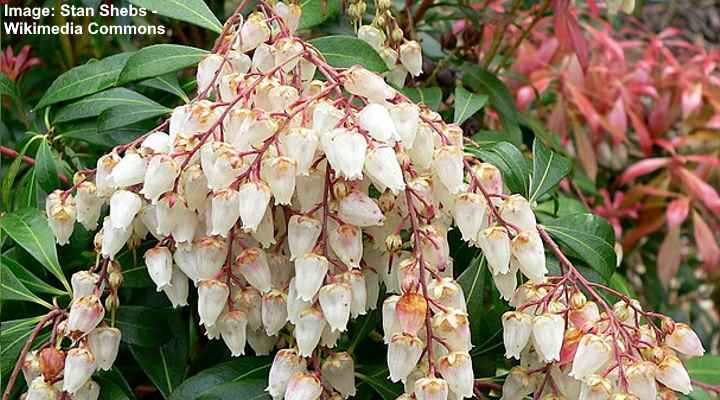
Japanese Pieris shrub has attractive white and pale pink flowers that look like upside down bells
Japanese Pieris is an evergreen ornamental shrub with large dangling clusters of small pinkish-white bell-shaped flowers. The showy white flowers with their pointed urn shape blossom in late winter or early spring and appear on arching stems. These showy panicles can grow up to 6” (15 cm) long.
Dwarf varieties of Japanese Pieris are ideal decorative shrubs for the front of house. The shade-loving shrubs perform best in USDA zones 4 through 8. And the dwarf shrub Pieris japonica ‘Cavatine’ only grows 3 ft. (1 m) high.
Japanese Pieris also goes by the name lily-of-the-valley bush because the white bell-shaped flowers are remarkably similar. Other names for the slow-growing flowering shrub are fetterbush and Japanese andromeda.
Doghobble (Leucothoe)
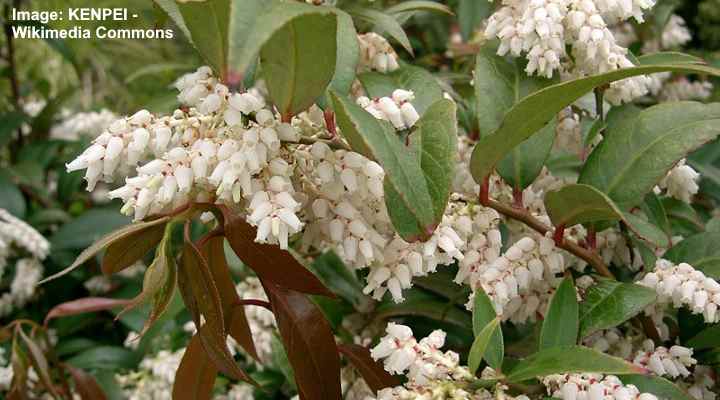
Doghobble is an evergreen shrub with delicate white bell flower clusters for both full sun and shaded areas
Doghobble is a decorative evergreen shrub with dangling clusters of ivory-white bell-shaped blooms. These showy, fragrant clusters of cupped flowers blossom in spring, creating conical drooping clusters measuring up to 3” (7.5 cm) long. In winter, the small shrub retains its visual appeal when its evergreen foliage turns bronze or purple.
White-flowering doghobble grows 2 to 6 ft. (0.6 – 1.8 m) tall. You can grow the shrub as a flowering hedge, accent plant, foundation planting, or specimen plant. It thrives in USDA zones 4 through 6 and requires well-drained soil.
Plants With Purple Bell-Shaped Flowers
Many plants have purple bell-shaped flowers. These lilac, blue, mauve, or purple blossoms create attractive floral displays as they contrast with green foliage. Here are descriptions and pictures of some of the most spectacular flowers with small flowers in the shape of bells.
Bluebells (Hyacinthoides)

Bluebells are bulbous perennials with purple bell flowers that can be found in shaded areas
Bluebells are the most recognizable purple bell-shaped flowers. The dainty dangling bluish-purple flowers blossom on arching stems, each having between four and 16 scented urn-like flowers. The nodding purple flowers grow among strap-shaped light green leaves. When growing en masse, the clumping perennials can transform shaded forest floors into a carpet of purple hues.
Bluebells are typically violet blue in color and consist of fused petals creating a bell shape. However, some varieties of bluebells can be pink or white.
Bluebells thrive in USDA zones 4 through 10 and grow between 1 and 2 ft. (30 – 60 cm) tall. You will find them growing naturally in shaded conditions. However, you can plant bluebells as ground cover, underplanting for shrubs, or in containers.
Campanula
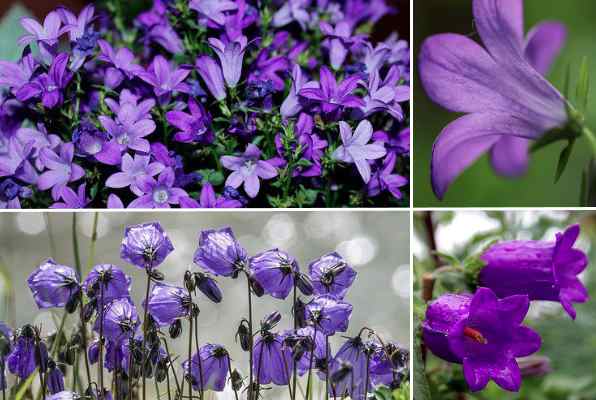
Campanulas include many varieties with bell flowers in shades of purple, blue, pink, or white
Also called bellflowers, campanulas have characteristic large bell-shaped purple flowers. The five-lobed corolla (petal or modified leaf) forms a cup shape to give the distinctive shape of the flower. Each flower measures 0.8 to 2” (2 to 5 cm) long. Although the bell flowers are typically purple, they can also be pink or white.
The botanical name of Campanula also refers to the distinctive bell shape of the flowers. In Latin, the plant’s name means “little bell.”
There are over 500 species of campanula plants. They range in size from dwarf alpine species growing 2” (5 cm) tall to large plants reaching 6.5 ft. (2 m) tall. As well as bell-shaped pink, white and purple flowers, campanulas also have tubular, cup-shaped, and umbrella-shaped flowers.
Bluebill (Clematis pitcheri)
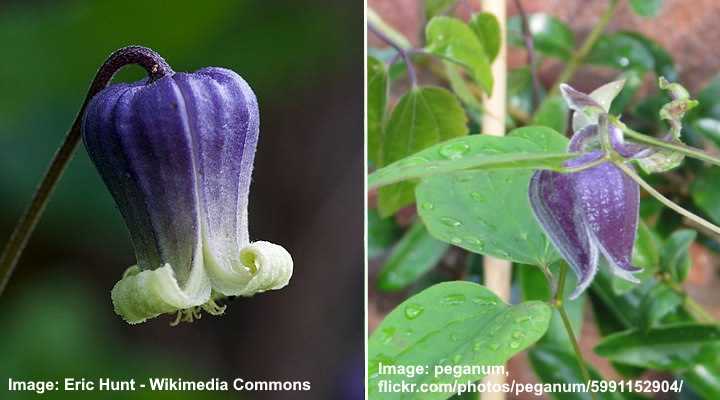
Clematis ‘Pitcheri’ is also called leatherflower clematis and has purple urn-shaped flowers with recurved white tips
Bluebill is a purple vining plant with nodding bell-shaped purple to lilac flowers. The spring-blooming flowers measure 1” (2.5 cm) long and have a bulbous base, narrower open end, and recurved tips that can be creamy white. Clematis pitcheri grows 10 to 13 ft. (3 – 4 m) tall and up to 3 ft. (1 m) wide.
One of the attractive features of Clematis pitcheri is its long blooming season. The bell-shaped purple flowers emerge in late spring and bloom profusely through summer until fall.
Bluebill thrives in USDA zones 5 through 9 in full sun and well-drained soil. Its tolerance for poor soil types makes it an ideal vining plant for sandy or rocky soils.
Canterbury Bells (Gloxinia perennis)
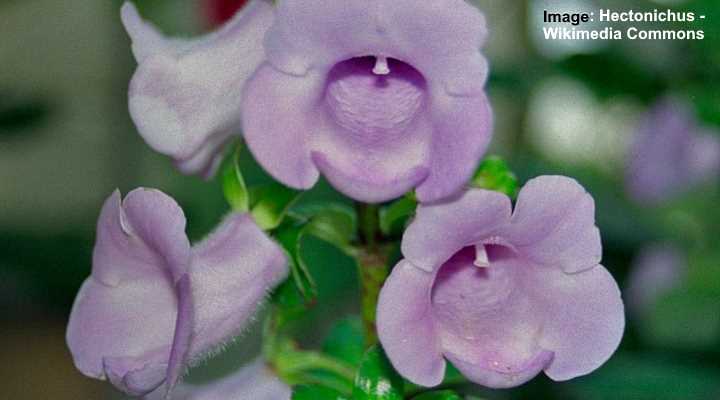
Canterbury bells are tropical plants with pale pink bell shaped flowers that prefer partly sunny location
Canterbury bell plants have easily recognizable lilac flowers in the shape of an ornamental bell. The pale purple or lavender flowers have a tubular body and large recurved rim. Each attractive bell flower measures around 1.5” (4 cm) long and gives off a minty scent.
Canterbury bells are also called bellflowers, but they’re not to be confused with plants in the Campanula genus. The bell-shaped purple flowers grow on erect stems 2 to 4 ft. (0.6 – 1.2 m) tall. These pale purple flowers bloom from summer until late fall.
Persian Lily (Fritillaria persica)
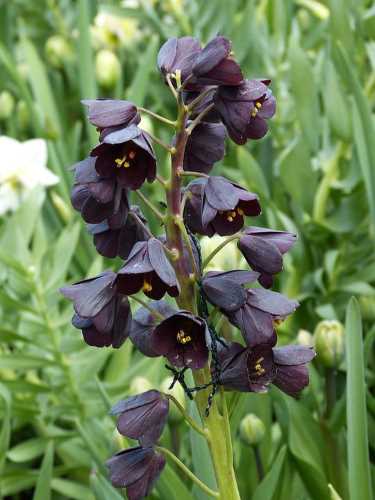
Persian lily is a bulbous perennial with striking dark purple bell-shaped flowers
One of the most unusual bell-shaped purple flowers is the Persian lily. The striking nodding flowers are typically a deep, plum-purple color, making them appear as black flowers. The dainty downward-facing flowers have an open bell shape, and they grow the length of the stem up to 4 ft. (1.2 m) tall.
Dark purple Persian lily flowers can bloom in stunning ivory-white or green colors. The flowering plants thrive in USDA zones 4 through 8 and perform best in full sun and well-drained soil. The best way to grow Persian lilies is massed in beds or borders.
Grape Hyacinth (Muscari armeniacum)
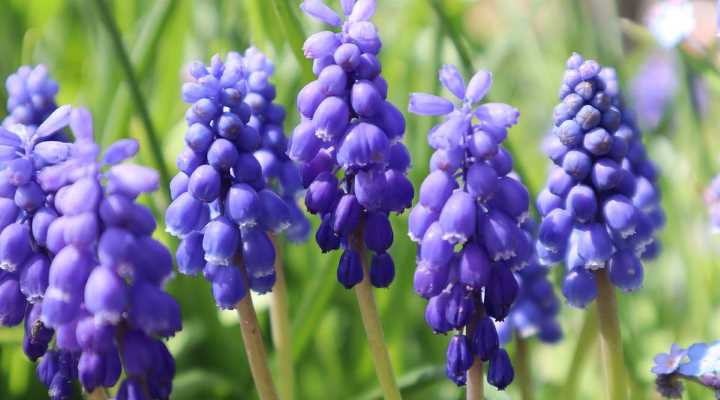
Grape hyacinth is bulbous perennial flowering plant with urn-shaped purple flowers suitable for sun to part shade
Grape hyacinth is easy to identify due to its deep blue or purple bell-shaped flowers growing in clusters at the end of stout stems. The tubular, oval flowers resemble small upside-down bunches of purple-bluish grapes. The bulbous plant produces a 4” to 8” (10 – 20 cm) flowering stalk with up to 40 tightly packed urn-shaped flowers on each one.
Due to its low-growing nature, grape hyacinth is an ideal plant for growing along borders, pathways, or in front of beds. They are also perfect container plants.
You can grow grape hyacinth in USDA zones 3 through 9. The bulbs produce flowering stalks and leaves in early spring, then die back in the summer. They then emerge again in mid-fall and persist through winter.
Plants With Red Bell-Shaped Flowers
Plants with red flowers that look like tiny bells help to add a vibrant pop of color to a garden landscape. Please read on to find three of the best varieties of plants with red bell-shaped flowers.
Coral Bells (Heuchera)
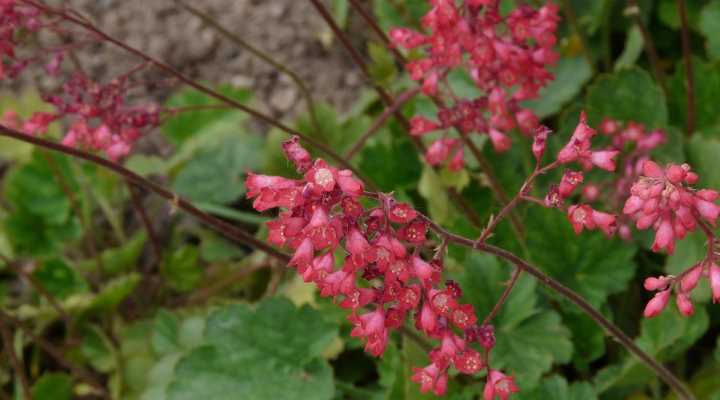
Coral bells are perennial plants with reddish tiny bell flowers that prefer morning sun and shade for the rest of the day
Coral bells are typically known for their colorful foliage. However, the semi-evergreen plants also produce slender stalks with tiny bell-shaped red flowers. The conical flower clusters emerge in spring as light pink to reddish pink flowers growing on dark red stems. These panicles can grow up to 13” (32 cm) above the colorful evergreen foliage.
Coral bells are ideal ground cover plants for partial sun to partial shade. The clumping perennials or evergreen plants (depending on the climate) thrive in USDA zones 4 through 9. The colorful leafy foliage can be red, yellow, chartreuse, dark purple, or coral red. The colorful plants grow 1 to 2 ft. (30 – 60 cm) tall and wide.
Fuchsia
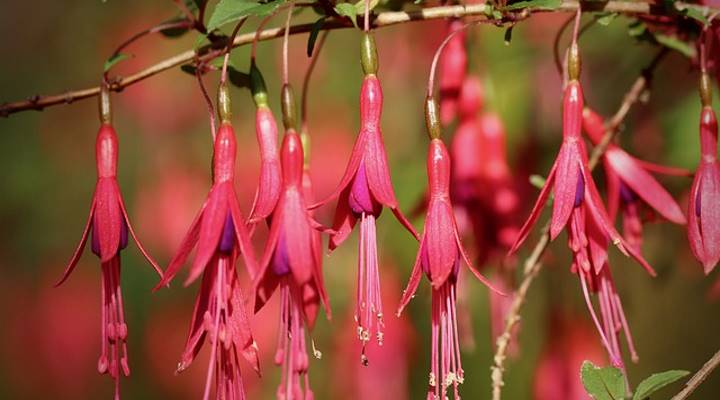
Fuchsia is a fast growing climber with attractive drooping bell flowers in various shades of red, pink and purple
Fuchsia is a species of exotic flowering plant with red, pink and purple bell-shaped flowers. The rounded, tubular flowers dangle from woody stems, characterized by long protruding stamens. The bell-shaped red flowers dangle on long petioles and bloom from spring through fall.
Fuchsia flowers thrive in USDA zones 10 through 12. They perform best in partial to deep shade and typically need protection from direct hot summer sunlight.
You can enjoy the red bell-shaped fuchsia flowers in temperate climates by growing the plant in a hanging basket. It will thrive in a shaded patio in summer, and you can overwinter it indoors from fall until late spring.
Orange Bell Lily (Lilium grayi)
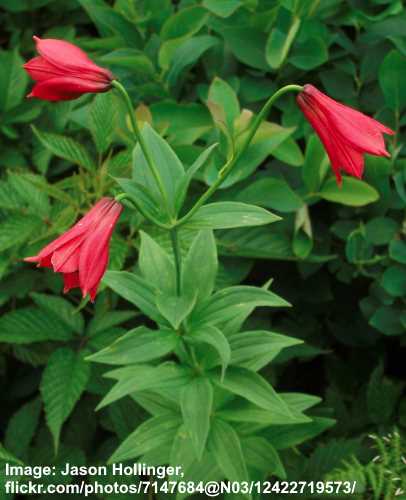
Orange Bell Lily (Lilium grayi)
Orange bell lily is a native plant with reddish bell-shaped flowers that grow in meadows and grasslands. The wild plant is identified by its tall, leafy growth with orangey-red flowers emerging from the ends of stems. Unfortunately, orange bell lilies are difficult to propagate and generally are not used in garden landscapes.
Orange bell lily is on the endangered list of native plant species. It typically grows in open grasslands and mountainous regions in USDA zones 4 and 5.
Other Bell-Shaped Flowers
Apart from white, purple, and red bell-shaped flowers, other varieties of ornamental plants also have showy flowers in different colors. Here are some colorful types of plants with flowers in the shape of bells, including yellow bell-shaped flowers.
Angel’s Trumpet (Brugmansia)

The elongated bell-shaped flowers of angel’s trumpet can be yellow, white, orange, pink or red
Angel’s trumpet is one of the showiest flowering shrubs, with elongated bell-shaped yellow flowers dangling from leafy stems. The common name for Brugmansia refers to the tubular shape of the drooping flowers that more resemble a trumpet than a bell-like round flower. The huge yellow flowers can measure 6” to 20” (15 – 50 cm) long.
Angel’s trumpet flowers are typically pale yellow to golden yellow. However, the funnel-like flowers can also be in shades of orange, green, pink, white, or red. In addition to their beauty, the spectacular tubular flowers emit a pleasantly sweet fragrance in the evening.
Angel’s trumpet shrubs or small trees are suitable for growing in USDA zones 9 to 12. In colder climates, the shrubs with their long bell-shaped flowers can grow in containers if they get protection from freezing temperatures in the winter.
Foxglove (Digitalis)

Foxglove have stunning long bell flowers in various colors, mostly pink, purple, white and yellow
Foxglove is an easily recognizable plant with large, colorful bell-shaped flowers. The flowers in the shape of bells grow up on tall flowering spires. The tubular flowers can be pink, purple, yellow and white, and many varieties have speckled throats. Depending on the type, foxglove flowers can be tubular, funnel-shaped, or the traditional bell shape.
Foxglove flowers thrive in USDA zones 3 to 8, depending on the cultivar. The striking flowering spikes produce masses of outward-facing, pastel-colored bell-shaped flowers on the stems, which grow up to 4 ft. (1.2 m) tall. Foxgloves are ideal for the back of bed planting, foundation planting, or growing along an unsightly fence or wall.
Twin Flower (Linnaea borealis)
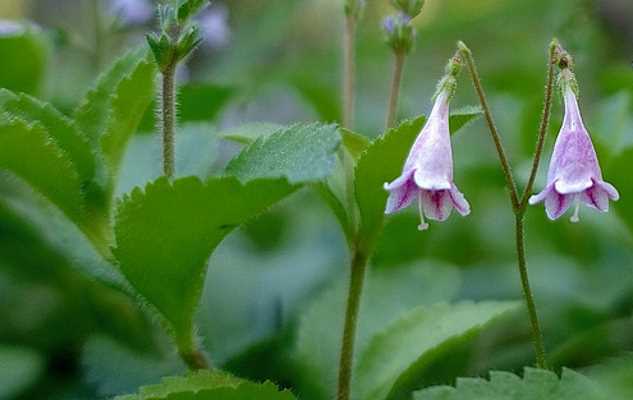
The cold hardy twin flower is a creeping evergreen shrub with pale pink bell flowers that grows best in partial shade
Twin flower (also twinflower) is an evergreen ground-hugging plant with pendulous dainty pink bell-shaped flowers. The name of the plant comes from the fact that the small flowers grow in pairs at the ends of slender stems. Each thin flower grows 0.28” to 0.47” (7 – 12 mm) long and is a pale pink color.
Additional identifying features of twinflower plants are their hairy stems, oval evergreen leaves with shallow lobbing, and small fuzzy seed capsules. Twinflower usually grows 3” to 6” (7.5 – 15 cm) tall.
Related articles:
